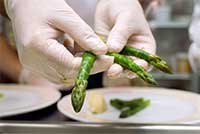Food Sanitation and Hygiene
Food hygiene constitutes a basic necessity of Good Manufacturing/Agricultural Practices and the development of Hazard Analysis Critical Control Point (HACCP), as well being as a component of all GFSI-benchmarked food safety standards. Government, industry and consumers all play a role in safe sanitation and food hygiene practices.
 Studies have shown that an appreciable percentage of foodborne illness cases can be attributed to poor sanitation and food hygiene, including poor personal hygiene and contamination of equipment and/or environments. Examples of food recalls related to sanitation issues include the contamination and subsequent recall of deli meats in Canada in 2008, when cells of Listeria monocytogenes were transferred to the product after surviving in equipment niches, where they were protected from sanitation procedures. The company was very public about the changes made to the sanitation program since then, including regular testing to monitor the success of the strategy in reducing environmental contamination.
Studies have shown that an appreciable percentage of foodborne illness cases can be attributed to poor sanitation and food hygiene, including poor personal hygiene and contamination of equipment and/or environments. Examples of food recalls related to sanitation issues include the contamination and subsequent recall of deli meats in Canada in 2008, when cells of Listeria monocytogenes were transferred to the product after surviving in equipment niches, where they were protected from sanitation procedures. The company was very public about the changes made to the sanitation program since then, including regular testing to monitor the success of the strategy in reducing environmental contamination.
Due to the risk, the Codex Alimentarius Commission provides an international code of practice concerning food hygiene: http://www.fao.org/docrep/005/Y1579E/y1579e02.htm. Within it, the following general prerogatives of the guidelines are laid out:
- Identify the essential principles of food hygiene applicable throughout the food chain (including primary production through to the final consumer), to achieve the goal of ensuring that food is safe and suitable for human consumption
- Recommend a HACCP-based approach as a means to enhance food safety
- Indicate how to implement those principles
- Provide guidance for specific codes which may be needed for – sectors of the food chain; processes; or commodities; to amplify the hygiene requirements specific to those areas
When designing a food hygiene and sanitation program, a total supply chain approach is crucial. The major areas to cover are:
- Equipment
- Environment
- Air
- Water
A key thing to note about these areas is that they function not as a static entity, but as a constantly evolving system. This is why good food hygiene programs need to be responsive to the dynamics of the plant environment and emerging risks – the same proactive approach used when developing HACCP.
According to the Codex Alimentarius Commission, food hygiene should cover all of these elements throughout the supply chain (all GFSI-benchmarked standards have similar requirements for housekeeping and food hygiene, with details laid out in their respective guidance documents):
- Primary Production (environmental hygiene, hygienic production, handling storage & transport, cleaning, maintenance and personnel hygiene)
- Establishment – design and facilities (location, premises and rooms, equipment, facilities)
- Control of operation (food hazards, hygiene control systems, incoming materials, packaging, water, management & supervision, documentation & records, recall procedures)
- Establishment – maintenance and sanitation (maintenance & cleaning, cleaning programmes, pest control systems, waste management, monitoring effectiveness)
- Establishment – personal hygiene (health status, illness and injuries, personal cleanliness, personal behaviour, visitors)
- Transportation (general, requirements, use & maintenance)
- Product information and consumer awareness (lot identification, product information, food labelling, consumer education)
- Training (awareness & responsibilities, training programmes, instruction & supervision, refresher training
Cleaning and food hygiene procedures for the building, plant and equipment should be validated using visual, analytical or microbiological methods – and records should be maintained. For instance, swab samples can be taken from various places on equipment, floors, walls or drains, to test for the presence of contamination. Then, after applying a sanitation step, samples can be taken again and compared with the original results to ensure that the step is effective at reducing harmful microbes to safe levels. For certain high-risk materials (e.g. allergens, ruminant protein or ready-to-eat products), validation of procedures is mandated, with individual governments designating acceptable methods for cleaning of high-risk materials.
A comprehensive food hygiene and sanitation program leaves nothing to chance. Responsibility should be designated for each parameter:
- Frequency of cleaning
- Method (chemicals used, concentrations, materials – including colour-coded/segregated tools to prevent cross contamination of high-risk materials)
- Verification records to ensure that procedures are being carried out consistently and effectively.
- Acceptable limits for CCPs must also be scientifically-established and maintained with regular monitoring
- Training and communication throughout the organization, with clear leadership from management on food hygiene and sanitation
As with other areas of food safety, sanitation and food hygiene should be proactive. End-product testing is important, but a positive result in the end-product doesn’t tell you where the contamination originated. The overall food hygiene system, when applied at each point in the supply chain, is about managing risks before they result in a case of food contamination. Using common sense and food science based approaches, a well-designed food hygiene program can provide for proactive responses and risk-mitigation from farm to fork.
To have more articles like this emailed to your inbox, become a GFSR Member today!

